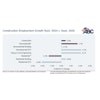
With the season slow or stopped, contractors are reflecting on how 2005 went, what 2006 will bring, and what they can do to squeeze another percentage of profit from the upcoming season.
Most contractors begin by looking at their financials, the breakdowns that show how much it cost the company for materials, labor, sales, office, and more. But as you look at the numbers (you do have the numbers to look at, don't you?) how do you decide what you can do to generate a little more profit? Sure, you can increase your gross sales (through more aggressive selling, marketing, or some type of expansion), assuming that if your gross margin percentage remains constant and with your fixed costs covered that most of your additional revenue after direct and indirect costs will fall to your bottom line. But that does require somewhere along the line an increase in fixed expenses (sales and administration) to support the additional revenue.
But if you simply want to determine if your company is performing at its optimum level, how do you go about doing that? What numbers do you look at, and, more importantly, how do you know if your numbers are where they should be so you can be as profitable as possible?
Well, 13 contractors throughout the United States have at least a little bit of a handle on how to make sure they're as efficient as possible, and they've agreed to share some of their information with Pavement readers. The 13 contractors, part of the Pavement Network, range in size from $5 million in annual sales to $30 million in annual sales. Among them they perform all types of paving and pavement maintenance work, though not all 13 companies perform all types of work.
"What's important is to look at your financials on a monthly, quarterly, and annual basis as a tool to help you manage your operation and find the strengths and weaknesses so you can capitalize on your strengths and turn your weaknesses into strengths. That's what financials are designed to do," says Harold Green, president, Chamberlain Contractors, a Pavement Network member. "When looking at financials it's not the bottom line profit that matters, it's understanding how you get to that bottom line that's important."
Over the past six years the Pavement Network has developed a financials reporting process that member companies use to report their financial figures to the entire group. The form, still being tweaked, tries to equalize much of the differences among the contractors so that the numbers, when crunched and available for analysis, are used in an agreed-upon standardized fashion.
The number crunching shows each member company's figures broken down into broad categories such as revenue, material costs, indirect costs, sales costs, and labor costs. Within each category members are encouraged to break their financial information down even more by type of work performed, for example, revenue generated, material costs, and labor costs for that type of work.
Not all members do this yet, but those that do have a better idea of how their costs line up with their revenues generated from a particular service category. They can determine, for example, that in a given month cracksealing revenue was $100,000, labor was $10,000 (10%), materials cost was $16,000 (16%), direct and indirect job cost $20,000 (20%), and gross profit (margin) was $54,000 (54%).
Rob Carr, with Network member Carolina Asphalt, says most contractors, including his company, keep a check on their operation by comparing actual financial figures to their annual budget. "When the financials are off budget then we know we have to take a close look and figure out why that happened and what we can do about it," Carr says.
But comparing your numbers to your budget doesn't offer the opportunity to compare to what other contractors are doing, and against a sort of benchmark. So the Network members use their financial statements to see how they relate to others who do similar kinds of work.
The Pavement Network crunched numbers and determined a benchmark—a weighted average for each of the categories its members track. The weighted average is essentially the median within each category. Each season when financials are submitted and crunched, each contractor receives information on how a particular category is performing relative to the weighted average.
A rating of zero indicates that the company's finances are statistically equal to the median for that category. A minus number (-1, -5 etc.) indicates the company is performing 1% or 5% worse than the median. A positive number indicates the company is performing better than the median. Members who are underperforming the median can then examine how much they differ from their peer group and what, if anything, they should do about it.
"One of the most important aspects of the Pavement Network is that we each have a number of other companies to turn to help us solve problems or to get another perspective on what we're doing," Green says. "There's a real value to being able to talk with someone who does the same kind of work you do."
So a member reporting, for example, a -22% difference in paving material costs might turn to a member with a +5% rating to see what they have in common—and what they don't.
[Note: Pavement Network has documented that material costs is one of the more difficult areas to tweak. These costs are the hardest to analyze because there's a great volatility among material costs in different parts of the country. But even though they can't be reduced as much as other costs, simply knowing the costs by job type and knowing that's one cost that can't be altered significantly enables Network contractors to focus on other areas of financials where they can have a greater impact.]
But there are material cost factors that the contractors can look into: delivery costs, number of suppliers, accounts receivables payments, waste, and more. By discussing these costs with another member, a contractor might be able to realize some cost reductions he would not have thought about had he not learned his paving materials costs are out of line with other Network members.
Breaking even
Green and Carr say Pavement Network's financial matrices enable members to do something all contractors should do: determine a break-even point for each company, based on its operating expenses.
"You need to know your break even and your operating costs to feel assured that your year will be successful," Carr says. "You want to have a lot of upside in operating."
Green says that contractors who don't know their break-even point put themselves in a position that can be risky and perhaps lethal for the company. "If the break-even point is low, then the upside potential is very great and you can look to a good and very profitable year," Green says. "But if the break-even point is high, if you have to do 80% or 90% of capacity just to cover your operating costs, you have a limited profit potential. You need to then look at costs to reduce your breakeven point and increase profit opportunities."
Plus, any company with a high break-even point risks not being able to cover its operating costs should the market become weak or material costs (fuel, hot mix, sealer) or even replacement equipment costs rise unexpectedly. Once a contractor knows his break-even point he can begin to analyze other financial categories to see what he might be able to do to reduce the break even or to increase sales.
"One of the things that becomes evident through this process is that not all problems, and not all solutions, are cost related," Green says. "In some cases they are sales or even pricing related and the answer or solution is to raise your prices."
Insurance savings
Green says the Network's biggest impact has been in helping members control general and administrative costs and labor costs. He says when they began comparing G&A costs the first item that jumped out was insurance costs, which ranged widely among members.
So Network members took a closer look at their own insurance programs, talked with one another, and came up with a few fairly basic suggestions members were able to implement to significantly reduce insurance costs while maintaining or even improving coverage.
One of the things they learned, which other contractors can easily take advantage of, was that members with lower insurance costs had policy renewal dates that were not year-end dates. By moving policy renewal dates to those times of the year when they weren't as busy, Network members could take the time to analyze their options, compare prices, and shop their business around. Combined with other insurance tweaks, Pavement Network member companies in 2004 were all within 1% of the median insurance costs.
Analyzing labor costs
Labor costs are difficult to analyze, not only because of regional differences in wages but because some contractors must hire union labor, which significantly raises their labor costs. In other areas where labor is plentiful the costs are skewed unusually low relative to contractors in other areas.
The financial matrix the Network is working from attempts to equalize these factors as much as possible. "But at certain points we just have to realize that one member is going to have higher or lower labor costs simply because of where he's located and there's nothing we or he can do about that," Green says.
Some Network members break labor costs down by type of work and some don't. By breaking it down by type of work it gives contractors a better opportunity to tweak their labor costs because they have more detail with which to work. Pavement Network figures showed that Total Direct Labor Costs ranged from 11% to 17% of sales, or 11% to 28% of total operating costs.
Another interesting labor-related category in Pavement Network financials is gross sales per employee per year, which ranged from a low of just under $139,000 to a high of $196,000. This metric is an overall indicator of how efficient your company is being managed and it's a simple calculation for any contractor to make, dividing gross sales ($1 million, for example) by the total number of employees (let's say 10) for gross sales per employee of $100,000 ($1 million ÷ 10 = $100,000).
What does it mean if your company averages $100,000 gross sales per year per employee? Not much, in and of itself. There are likely good reasons you are lower than the Pavement Network's contractors. Perhaps your business is seasonal due to location or services offered as compared to Network members. Or perhaps you only offer a single service, sealcoating for example, where Network contractors generate more sales out of each visit to a property (crackseal, sealcoat and striping).
What's most important is what these gross sales per employee numbers show over time. Contractors who track gross sales per employee on a monthly basis most likely can expect gross sales per employee to decline in off-season months; year to year, however, they should actually grow in peak months as the business grows.
If you realize that per-employee sales are sliding in what should be a busy month, that's something you need to look at. Are you less productive? Is old equipment breaking down? Do you have a lot of new employees who are slowing work because they need to be trained so aren't as productive? Are you bidding with tighter margins to get the job? Are your sales people not meeting their goals? Any number of these or other reasons (or combination of reasons) can result in lower gross sales per employee, but it's important that contractors recognize the change so they can make any adjustments in their business to compensate for it.
The buddy system!
But not everyone is or can be a member of the Pavement Network, so how does this approach help other contractors?
"People need to overcome the fear of allowing others, particularly others in the same industry, to see what goes on in their company," Green says. "That's not to say you want everyone looking into your numbers and it doesn't mean you're going to show your competitors what you're doing. We're all competitive; that's what makes a business person successful."
Green says Pavement Network members are located geographically far enough away from each other so they do not compete directly; other contractors can help themselves by finding a contractor like themselves in another part of the country.
"It can be just one-on-one or you can have more people involved, but you have to have a rapport with them and you all have to be willing to reveal information that you might not have revealed up to this point."
Green says it's also important that the people you engage with are candid and willing to talk openly about their business as well as yours.
"The advantage of connecting with a contractor in a different area of the country is you aren't competing and you aren't going to be stepping on each other's toes, so there really should be no reluctance on either part to reveal or discuss information," Green says.
Green and Carr stress that collecting, organizing, and analyzing a contractor's financials is an essential step toward a thriving, growing, and profitable business. Financials provide the detail contractors need to make the best decisions for the profitability of their operation. But by collecting them you can determine if there has been a change in what it costs your company to do business—or possibly what you are charging for your work. By identifying these changes you can better determine how to react to your market to improve your business and, ultimately, your bottom line.




















